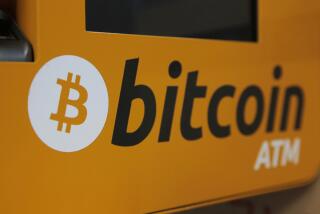Bitcoins: Widely known and widely misunderstood
Back in the 1980s, when I lived in Nairobi, foreign residents had a simple way of obtaining Kenyan shillings.
They’d write a check in, say, U.S. dollars on their U.S. bank accounts to the Indian man who owned the ice cream store down the block. He’d pay over shillings at the current black market rate. Then he’d mail the check to his brother in Toronto, who would deposit it in the merchant’s name in a Canadian bank account.
Presto! The expatriates got shillings to spend locally, and the shop owner spirited his profits out of the country for conversion to a hard currency, secure for his retirement. Everyone was happy (except possibly the Kenyan government, whose tax and foreign-exchange laws were being flouted.)
I’ve been thinking that the ice cream man would be a perfect customer for bitcoins today.
You’ve probably heard of bitcoins. They’re a virtual currency, meaning they exist nowhere but on a network of ledgered accounts owned by people all over the world. The system is decentralized, so it’s not under the control of any government or, arguably, any single authority at all. Bitcoin values are set not by a government authority but partially through a complicated mathematical algorithm and partially by what people think they should be worth at any moment.
As a result, their value has been highly variable — over just the last month the price of a single bitcoin has been quoted by Mt. Gox, a leading exchange agent, as low as $190 and as high as $900.
Bitcoins have been much in the news lately, not entirely for reasons that delight their promoters. One was the FBI’s shutdown of Silk Road, an online marketplace where sellers peddled drugs, firearms and other illicit goods and services, taking bitcoins as payment. That pointed to how the relative anonymity of bitcoin transactions is supposed to be great for criminals, who obviously appreciate being able to evade tracking by law enforcement as they move assets around the world. (Silk Road’s alleged San Francisco-based mastermind, Ross Ulbricht, was denied bail last week by a federal judge in New York.)
The other event that has put bitcoins on the map was a hearing last week by the Senate Committee on Homeland Security and Government Affairs. The session aimed to give federal regulators a chance to talk about how they’re dealing with a medium of exchange that works outside of government coinage and the established banking system. Their testimony conferred legitimacy on the bitcoin simply by showing that the regulators are not especially inclined to outlaw it — in fact, to a certain extent they welcome it.
So bitcoins have reached that point in public awareness where their existence is becoming widely known, and widely misunderstood. Some people think of bitcoins as investment vehicles — an opportunity to get rich by getting in at the ground floor. Others think of them as weapons against nefarious central banks and their inclinations to debase currency. Both impressions are certainly wrong.
The only people who see bitcoins as opportunities to make a killing are insiders, of whom there are few, and rubes, of whom there are too many to count. A mutual fund for investing in the things has even been launched by the twins Cameron and Tyler Winklevoss, who got famous for claiming that they created the idea for Facebook and were mulcted out of their fair share of the spoils by Mark Zuckerberg. After observing that the offering’s registration statement bristled with risk factors, the august Financial Times reported, “something tells us this is one Winklevoss-innovation Mark Zuckerberg won’t be stealing.”
As for the creation of an independent world currency outside the control of established governments, dream on — central bankers are not fools, and they’re much more likely to co-opt the bitcoin system than bow to it. In fact, the co-opting process is already underway.
First, a quick history of bitcoins. They were invented in 2008 by a computer programmer or programmers using the pseudonym Satoshi Nakamoto. His, her or their identity is still unknown. The idea was to create a system of electronic cash operating outside the existing financial system. Bitcoins exist as entries in encrypted online accounts; you use them to pay or be paid by transferring them, or a fraction of them, from your account to your counterparty’s account, with the transfer validated by computers on the network so that you can’t spend more bitcoins than you own. (The validation isn’t instantaneous, so even the smallest bitcoin transaction involves a 10-minute delay.)
The cleverest part of the bitcoin story is how they’re created, or “mined.” This is done by rewarding computer operators for solving a mathematical algorithm that grows more difficult over time, so that it becomes harder to add to the store of bitcoins — just as it’s harder to add to the world reserve of gold over time. Today there are about 12 million bitcoins in circulation, worth a little over $9 billion at Friday’s quoted price of $760. The mathematical algorithm dictates that there will never be more than 21 million bitcoins, the last of which is expected to be “mined” by 2140.
Although a Bitcoin Foundation informally oversees this network and its rules, there’s no single governing agency — the system is based on open-source software and designed to be self-policing.
What all this means is that bitcoins are real, in the sense of being units of value that can be transferred. But despite the aspirations of some of their promoters, they’re not real currency because they have no value outside the non-bitcoin world, as gold does. Nor do they have value placed on them by the fiat of a central government, as do dollars or deutsche marks.
That’s why their value quoted in legitimate currencies fluctuates so widely. The originators of bitcoins may have been motivated by mistrust of central banks or fears of runaway inflation to create a pristine new international currency, but as Francois Velde, an economist at the Federal Reserve Bank of Chicago, recently observed, “it is hard to imagine a world where the main currency is based on an extremely complex code understood by only a few ... without accountability, arbitration, or recourse.”
On the other hand, their value as instruments of transfer is obvious. That’s where the Kenyan ice cream man might benefit. If he had a bitcoin account and access to a computer connection, he could simply ask his customers to pay him for their Kenyan shillings by putting dollars in his account, where they would be denominated in bitcoins, then convert those into Canadian dollars and deposit those in a Toronto bank. Not even a check would have to be mailed.
That’s probably how bitcoins are mostly used today — for international transfers needing to be done quickly, say by bank account holders in Greece or Spain worried that their assets, denominated in local currency, were threatened by government devaluation. If the transfers are done fast enough, bitcoins’ value fluctuations don’t matter.
“You just move the money in, move it across the ledger, and move it out again,” says Susan Athey, an economist at Stanford. “In principle, you need to only worry about the exchange rate for 10 minutes.” Athey says it’s the transfer mechanism that’s really revolutionary. “All these articles about how bitcoin has moved from $100 to $500 are missing the point,” she says. “The point is that we have a new technology that allows any individual in the world to send value from one place to another instantly, in a way that’s secure and verifiable.”
That’s a warning to traditional banks. “Some of their policies do seem archaic,” Athey says, mentioning the inordinate delays and fees involved with moving even modest sums from your bank to your broker. “Having an alternative will put a lot of pressure on these systems to modernize.”
In fact, the system doesn’t have to be based on bitcoins — Ripple, a service to which Athey is a consultant, says it accomplishes the same goal without bitcoin’s 10-minute delay. As the technology spreads, it will have an impact on users from big businesses to minimum-wage migrant workers remitting their pay back home, where the availability of smartphone connections may well be outpacing the availability of banking services.
It will still take time for the bugs to be worked out of the new technologies and their real virtues to become better appreciated than their superficial pizazz.
Nor is the system especially secure, as its promoters claim. At least, it’s no more secure than the online systems of big banks and retailers, which are routinely hacked; one bitcoin user forum lists dozens of thefts of bitcoins from encrypted accounts.
As for bitcoins’ usefulness for criminal activity, that’s not going to be the making of bitcoin, or of any other virtual currency. As Jennifer Shasky Calvery, director of the Treasury Department’s Financial Crimes Enforcement Network, told the Senate committee last week, “legitimate financial institutions do not go into business with the aim of laundering money on behalf of criminals.” And the bitcoin community desperately wishes to be considered legitimate.
Calvery reported that the Treasury has already made bitcoin exchanges subject to the Bank Secrecy Act and other regulations. The digital currency business is still embryonic — that $9 billion in existing bitcoin value is dwarfed by the $1.2 trillion in U.S. currency circulating around the globe. As it grows, you can expect central banks, government treasuries and law enforcement agencies to find ways to keep their arms around it. (Remember the predictions that cellphones would make government wiretaps impossible? Didn’t happen.)
Much of the discussion of bitcoins today focuses on whether the digital currency is doomed, or here to stay. Asking the question that way will give the wrong answer. Bitcoins themselves may or may not survive, but the technology that spawned them certainly will. Ice cream shop owners around the world can bet on it.
Michael Hiltzik’s column appears Sundays and Wednesdays. Read his new blog, the Economy Hub, at latimes.com/business/hiltzik, reach him at [email protected], check out facebook.com/hiltzik and follow @hiltzikm on Twitter.
More to Read
Inside the business of entertainment
The Wide Shot brings you news, analysis and insights on everything from streaming wars to production — and what it all means for the future.
You may occasionally receive promotional content from the Los Angeles Times.











